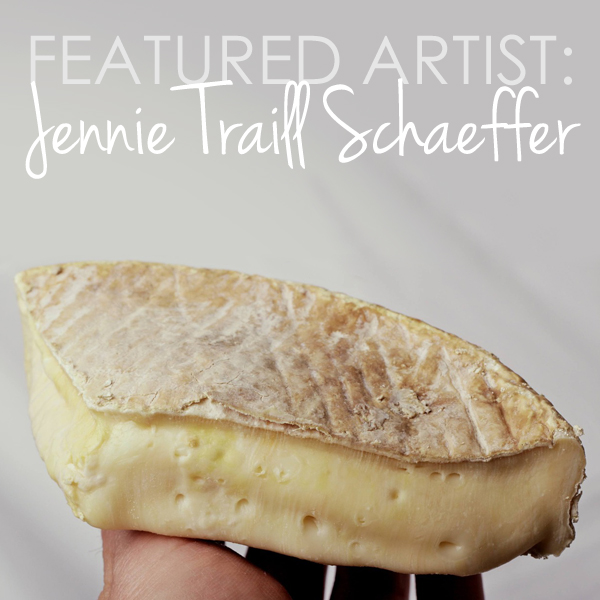 i choose CHEESE
i choose CHEESE
With the arrival of January, I finally been able to concentrate on comfort –and yearly nesting maintenance of both my literal home and second home, this blog. My own art is still in flux and the reduction of my belongings in in full swing. As I prepare to purposefully downsize once again, I am happy to be liberating my belongings into the hands of others who are more interested than I in owning stuff. As you might imagine, I seem to be divesting myself of kitchen wares the slowest. I let go of the ice cream maker this week. But, between you and me, I did add a digital thermometer for cheese making. I mean really, doesn’t everyone need 6 sizes of melon ballers? Of course.
This month’s artist both celebrates and laments our kitchen icons. Her work explores our connection to the tools of domesticity and the roles they play in defining our roles in life–real and imagine, chosen and not. Separating me from my mixer just got harder.
 AAAD is proud to feature the work of Jennie Traill Schaeffer. This work calls attention to how what we own speaks to who we are. It isn’t all pots and percolators...
AAAD is proud to feature the work of Jennie Traill Schaeffer. This work calls attention to how what we own speaks to who we are. It isn’t all pots and percolators...
FEATURED ARTIST:
Jennie Traill Schaeffer
Contemporary artist Jennie Traill Schaeffer holds a BFA in Painting and Art Education from Syracuse University’s College of Visual and Performing Arts. She studied with painters Jerome Witkin, Gary Trento, and John Thompson while studying abroad in Florence, Italy. Jennie received the “Hiram Gee Award,” given each year to a graduating senior painting major.
Jennie grew up in Easton, Pennsylvania, and comes from a lineage of happy artists (visual, musical, and performing). She and her husband, Lee Goldberg, are happy to now call New Jersey home along with their adorable sons, Joel & Auggie–and exuberant dog, Ringo.
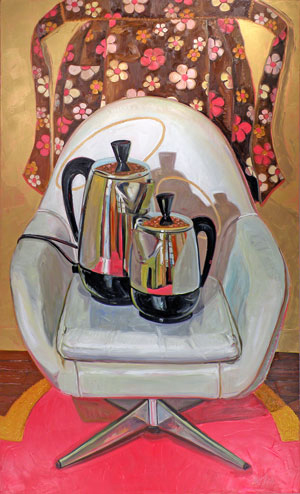 Tell me about your art education–both the self-taught and the formal instruction. “I hold a BFA in painting and art education from Syracuse University. The technical foundations of painting I developed while in art school, but in order to continue painting in oils safely in my home while pregnant, I researched and taught myself to paint without solvents. Over the past decade, I’ve experimented with direct painting using both brushes and knives, adjusting my style.”
Tell me about your art education–both the self-taught and the formal instruction. “I hold a BFA in painting and art education from Syracuse University. The technical foundations of painting I developed while in art school, but in order to continue painting in oils safely in my home while pregnant, I researched and taught myself to paint without solvents. Over the past decade, I’ve experimented with direct painting using both brushes and knives, adjusting my style.”
How has your technique developed over the years? Does your substrate determine the texture of the final work? Do the works on paper have the same topography as the work on panel? “A mixture of indirect and direct painting stuck with me from art school, but due to my need to remove solvents from my studio, my paint application thickened. Now because of both time constraints in the studio due to caring for children, as well as painting mostly without a vehicle, my painting process if very direct. However, I’ve always been attracted to the play of thick paint moving around a surface. That visceral feeling of applying paint is one of my first memories of learning to paint. It’s usually in the end layers when the paint is still wet and I’m able to lay in other colors, brushing in texture, when I’m happiest at the easel. When I shift to works on paper it’s usually to switch to a drawing or printmaking medium, so that will dictate the texture of my work.”
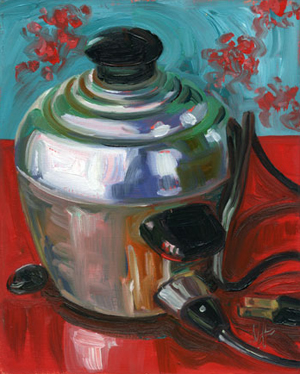 It would seem you have a significant relationship with the kitchen. With such a prolific portfolio of cutlery, aprons, appliances & more, it has to more than just a matter of kitchen convenience. Yes? ‘An argument between my, then, fiancée, now husband and I. We both love to cook, and when we were first living together and engaged, we both shared the responsibility. He was in graduate school and I was working at an art store and setting up a studio at home. I was trying to figure out what to paint. After having a huge disagreement over how and when to wash our pots and pans, I painted my dishwasher, which was in view of my dining room studio. We registered for wedding gifts, many of which were domestic kitchen appliances. I began painting them as portraits, not sure of the meaning at the time, but attracted to their design, reflective qualities, and color. Along the way, I realized the import of what I was painting –Icons of the Kitchen. They are heavily marketed tools that many in my generation don’t use, but desire to have as a status symbol. Once I was aware of this, I began donning the appliances with halos and seating them on thrones evoking references to religious paintings from the Early Renaissance.”
It would seem you have a significant relationship with the kitchen. With such a prolific portfolio of cutlery, aprons, appliances & more, it has to more than just a matter of kitchen convenience. Yes? ‘An argument between my, then, fiancée, now husband and I. We both love to cook, and when we were first living together and engaged, we both shared the responsibility. He was in graduate school and I was working at an art store and setting up a studio at home. I was trying to figure out what to paint. After having a huge disagreement over how and when to wash our pots and pans, I painted my dishwasher, which was in view of my dining room studio. We registered for wedding gifts, many of which were domestic kitchen appliances. I began painting them as portraits, not sure of the meaning at the time, but attracted to their design, reflective qualities, and color. Along the way, I realized the import of what I was painting –Icons of the Kitchen. They are heavily marketed tools that many in my generation don’t use, but desire to have as a status symbol. Once I was aware of this, I began donning the appliances with halos and seating them on thrones evoking references to religious paintings from the Early Renaissance.”
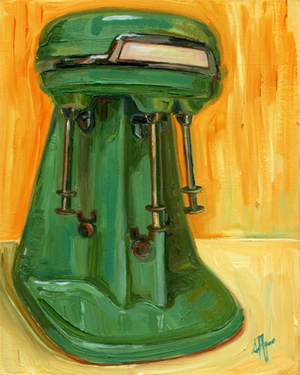 Speaking of appliance portraiture, how is it that even the spoons feel as though they are sitting for portraits? “I love to paint portraits, but have a fear of having people sit for me and prefer to paint from life when possible. I think the appliances fill that need for me and feel like portraits due to their scale and positioning. They are not arranged in a typical still life grouping, but are situated on non-descript surfaces with cords and handles that have seem to suggest hands on hips. Of course the appliances seated on chairs is obvious. In many cases, though not all, they are larger than life.”
Speaking of appliance portraiture, how is it that even the spoons feel as though they are sitting for portraits? “I love to paint portraits, but have a fear of having people sit for me and prefer to paint from life when possible. I think the appliances fill that need for me and feel like portraits due to their scale and positioning. They are not arranged in a typical still life grouping, but are situated on non-descript surfaces with cords and handles that have seem to suggest hands on hips. Of course the appliances seated on chairs is obvious. In many cases, though not all, they are larger than life.”
Producing vintage-inspired work that isn’t sentimental takes a careful hand. Both your color palate and your composition speak to a vintage perspective. Was that your intention? “I am drawn to, have been fascinated, and sometimes disgusted by the era my parents group up in. For the most part, I would not have wanted to be a woman during the earlier 20th century, but I appreciate the work women did in the home. The color palette comes from the objects themselves, many of which are vintage-inspired in their design. The composition is vintage in that I am referencing older works of art. But removing the sentimentality wasn’t intentional, and the pieces do evoke an emotional response from viewers. I think the removal of the objects from their environment, along with the historical references maybe tames the sentimentality.”
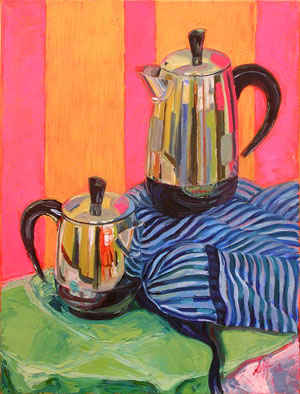 What style or school of art do you think work fits into? I’ve always found it difficult to pigeon-hole my work into a particular style. “The subject matter is Pop Art, but the intent is more a blend of Realism, Conceptualism, and a bit of Expressionism. I want the objects to be readily understood, and I enjoy depicting things realistically.”
What style or school of art do you think work fits into? I’ve always found it difficult to pigeon-hole my work into a particular style. “The subject matter is Pop Art, but the intent is more a blend of Realism, Conceptualism, and a bit of Expressionism. I want the objects to be readily understood, and I enjoy depicting things realistically.”
But, I am striving to convey meaning or a better understanding of who I am, who wives are, who mothers are through my work.
What is your favorite food addiction? “Pasta is my ultimate love. I grew up with a half-Italian father who has perfected an amazing spaghetti sauce chocked full of garlic, onions, a terrific balance of herbs and sausage and meatballs.”
What if your favorite snack food obsession? “I am definitely torn between chocolate and cheese. It’s trite, but when I’m itching for a snack and the “clean” or “healthy” option just won’t satisfy me, I look for a bag of chocolate chips in the baking cabinet or aged, extra sharp cheddar.” Chocolate vs. cheese is a question for the ages. And I would argue if both are high quality, they are both clean and healthy. Eat them both.
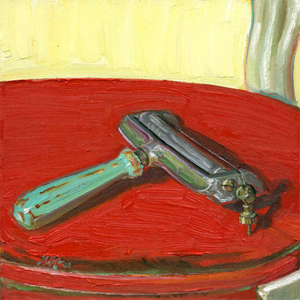 What’s coming up next for you? “I have a lot of ideas that I’ve jotted down, but none fully formed yet. Thoughts of kitchen icons or relics, creating more large maestás, incorporating more collaged egg shells into paintings, making a large piece painted on a bed headboard similar to an altarpiece.”
What’s coming up next for you? “I have a lot of ideas that I’ve jotted down, but none fully formed yet. Thoughts of kitchen icons or relics, creating more large maestás, incorporating more collaged egg shells into paintings, making a large piece painted on a bed headboard similar to an altarpiece.”
“I’m considering attempting a small lunchtime work each day featuring lunch ingredients.”
“Since I had my second child, 19 months ago, motherhood and art has been on my mind a lot. This may somehow creep into my subject matter. At the end of 2014 I created a linocut called St. Mixer of the Bags, which I printed on reusable bags. I would like to print a limited edition on paper, and then pursue more linocuts of my work.”

